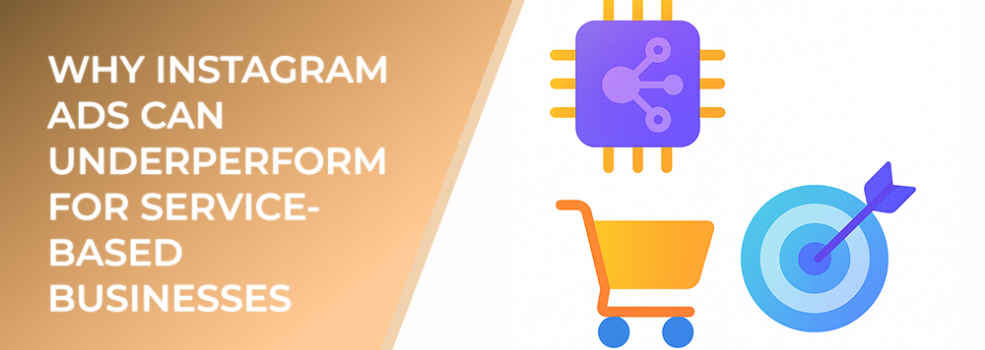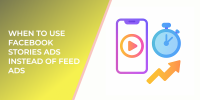Instagram is optimized for quick, visual engagement. Service businesses often sell invisible outcomes (expertise, trust, long-term results) that require context, proof, and conversation. When the buying journey spans days to weeks, the metrics Instagram optimizes for—views, likes, short interactions—don’t always translate into qualified leads.
Useful statistics at a glance
-
Lead quality gap: Service advertisers frequently report that Instagram leads convert to sales at 20–40% lower rates than Facebook Feed or Search leads when targeting similar geos and budgets.
-
Short-window bias: Campaigns measured on 1-day click windows show 15–30% higher CPA variance for services versus physical products.
-
Placement tilt: With auto placements, 60–80% of impressions can land in Reels/Stories—great for reach but often weaker for complex offers needing longer consideration.
-
Form friction: Instant Forms with too many fields reduce submit rate by 25–50%; forms that are too short increase junk leads by 20–35% without added qualification.
-
Scheduling lag: Leads that wait >15 minutes for a response see show-up rates drop by 30–50%, particularly for local services.
Ranges summarize patterns we see across service accounts; actual results vary by niche, geography, and sales process.
Why Instagram underperforms for services
1) Attention windows are too short for complex services
Reels and Stories are fast, silent-first environments. Nuanced offers (legal, medical, coaching, B2B) need depth, which rarely fits into a 6–10 second hook.
Fix: Use placement-aware assets—short hooks to earn the click, then rely on landing pages or longer Feeds videos that build proof.
2) Optimization event misalignment
Optimizing to link clicks or basic leads teaches the algorithm to find cheap clickers, not buyers.
Fix: Optimize to qualified events (e.g., Lead_Qualified, BookAppointment) and pass offline conversions from your CRM.
3) Weak lead qualification
Overly simple forms flood sales with unqualified leads; overly complex forms suppress volume.
Fix: Use 3–5 high-signal questions (budget, timeline, location, intent). Add conditional questions for high-ticket services.
4) Creative that entertains but doesn’t filter
“Pretty” visuals win attention but fail to repel the wrong audience.
Fix: Build creatives that attract and repel: price ranges, who it’s for/not for, timelines, and process shots.
5) Audience and placement overlap
Multiple ad sets targeting similar broad audiences compete with each other, inflating CPMs and muddying tests.
Fix: Consolidate and use exclusions. Keep one clean test lane next to your control.
6) Slow follow-up kills intent
Instagram scrolling is impulsive. If you don’t call or text fast, intent cools.
Fix: Auto-SMS/Email with booking link; goal is <5 minutes from submit to first touch.
7) Landing pages not built for mobile
Tiny text, slow load, or generic “Contact us” pages spike bounce and waste clicks.
Fix: Mobile-first pages: headline + proof, 3 bullets, 1 CTA, fast scheduler embed.
A pragmatic Instagram plan for service-based businesses
1) Structure & Objectives
-
Two lanes: Control (proven assets in Feeds + retargeting) and Test (Reels/Stories hooks that push to depth).
-
Optimize to BookAppointment or Lead_Qualified; keep attribution constant for comparisons.
2) Creative System
-
Produce 3 concept types each cycle: Problem→Solution, Proof (before/after, case clip), Process (behind-the-scenes, step walkthrough).
-
Add filters to pre-qualify: “Starting at $X,” “Service area: City/ZIP,” “Projects start in 2–3 weeks.”
3) Forms & CRO
-
3–5 questions: service type, location, budget bracket, timeline, contact method.
-
Use context cards in Instant Forms to educate before submission.
-
Embed a calendar on the thank-you page.
4) Speed to Lead
-
SLA: outreach in <5 minutes during business hours; <15 minutes after-hours with automated scheduling link.
5) Measurement & Feedback
-
Track qualified rate, show-up rate, close rate, and pipeline value by placement.
-
Tag creative concepts to learn which hooks produce real appointments.
Sample 2‑week test plan
Week 1
-
Launch 2 Reels hooks + 1 Feed video per service.
-
Use one Instant Form with 4 qualifying questions and a calendar handoff.
-
No edits for 72 hours; monitor cost per qualified lead.
Week 2
-
Prune losers; iterate best hook with clearer “who it’s for/not for.”
-
Add a Feeds-only ad set to compare against Reels‑heavy delivery.
-
Scale in 15–20% steps if qualified rate holds.
Troubleshooting checklist
-
Attribution: Did the window change mid-test? Keep it constant.
-
Placement skew: Are >70% of impressions in Reels/Stories? Add Feeds minimum or separate placement tests.
-
Lead quality: Are junk leads >30%? Add 1–2 disqualifier questions and a price cue.
-
Follow-up time: Is median response >15 minutes? Implement auto-text and calendar routing.
-
Landing page speed: Is mobile load >3s? Compress media and trim scripts.
Executive summary
Instagram can drive scale, but service offers struggle when optimization, creative, forms, and follow-up don’t reflect longer decision cycles. Align events with outcomes, qualify early, require mobile depth, and move fast on leads.

